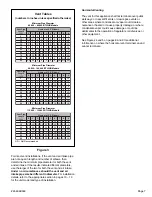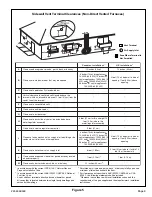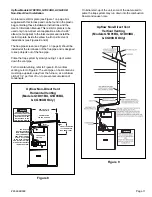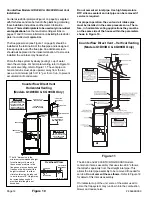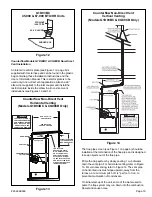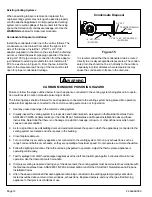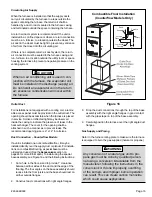
# 45466K003
Page 21
Refer to the furnace wiring diagram while using the
following procedure to change motor speed:
1. Turn off electrical power to the unit.
2. Connect the desired speed tap for cooling on the
blower control board.
3. For heating speed, check the temperature rise and, if
necessary, adjust the blower speed tap to maintain
temperature rise within the range shown on the
furnace rating plate.
To use the same speed tap for both heating and
cooling, install a piggyback terminal on the speed tap
using a short jumper. Wire 1/4" quick connect termi-
nals on both ends to jumper the
“
HEAT
”
and
“
COOL
”
speed on the blower control board.
4. The remaining speed taps must be connected to
dummy terminals marked
“
PARK
”
on the blower
control board.
Checking and Adjusting Gas Input
The minimum permissible gas supply pressure for the
purpose of input adjustment is 5" W.C. for natural gas and
11" W.C. for propane gas. This furnace requires conversion
for use with propane (see
Accessories
section on page 24
for correct kit). The maximum inlet gas supply pressure is
10.5" W.C. for natural gas and 13" W.C. for propane.
Gas input must never exceed the value shown on the
furnace rating plate. The furnace is equipped for rated
input at manifold pressures of 3.5" W.C. for natural gas or
10.0" W.C. for propane gas.
To measure the manifold pressure, disconnect the hose
and remove the barbed fitting in the downstream side of
the gas valve and connect a water manometer or gauge
(see Figure 20).
To adjust the regulator, turn the adjusting screw(s) on the
regulator clockwise to increase pressure and input; coun-
terclockwise to decrease pressure and input.
Replace the barbed fitting and reconnect the hose after
measuring and/or adjusting the regulator.
For Natural Gas:
Check the furnace rate by observing the
gas meter, when available, making sure all other gas
appliances are turned off. The test hand on the meter
x
3600 x
= Cubic Feet Per Revolution
BTU/HR
INPUT
# Seconds Per Revolution
Heating
Value
The heating value of the gas can be obtained from the local
utility company.
For Propane Gas:
The only check for the furnace rate is to
properly adjust the manifold pressure using a manometer
and Table 4 on page 22. Typical manifold set point for
installations at altitudes from 0 to 4500 feet above sea level
is 10.0" W.C.
Temperature Rise
Check the temperature rise and, if necessary, adjust blower
speed to maintain temperature rise within the range shown
on the unit rating plate.
High Altitude
In both the United States and Canada, this furnace is
approved for operation at altitudes from 0 to 4500 feet above
sea level without any required modifications. From 4500 to
7500 feet, the gas manifold pressure needs to be adjusted
according to the information shown in Table 4 on page 22.
To adjust the manifold pressure, refer to previous section
Checking and Adjusting Gas Input
. For installations
above 7500 feet, call Technical Service at 1-800-448-5872
ext. 2610 for assistance.
The furnace rate must be /- 2% of the
appliance rating input.
CAUTION
Figure 20
Checking and Adjusting Gas Input
should be timed for at least one revolution. Note the
number of seconds for one revolution.

